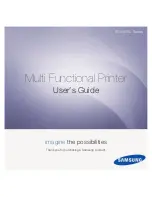
(2) Periodic checks
Check the items listed in the table below every 6 months, and correct
any problems.
Table of periodic checks
No.
Check items
Standard
Procedure
1
Dust, fuzz and dirt
sticking to various
parts.
•
The mechanism should not have a lot of dirt, fuzz or dust on its
surface. Foreign substances should not be allowed to collect.
•
Clean the unit with a vacuum cleaner.
•
The paper guide should not be clogged with paper chips, etc.
•
Remove paper chips with a tweezers.
2
Lubrication
•
See "Chapter 6".
•
Refer to "Chapter 6" For lubrication.
3
Operational check
•
Printing is operated without abnormality.
•
See "Chapter 5".
•
Feeding operated without abnormality.
•
Observe respective functions. Abnormal operation caused by parts
wear, deformation, bending, etc., do not exist.
•
See "Chapter 5" and "Chapter 6".
CHAPTER 5. TROUBLESHOOTING
Troubleshooting and repair of the printer is classified into two levels
(A and B), depending on the difficulty of the repair.
Persons undertaking a repair should consider their level of technical
skill and the level of the repair before attempting to ensure that the
trouble is handled correctly.
1. Repair Levels
Level A: This requires general knowledge about the operating princi-
ples and structure of the printer, along with technical skill
and minimum experience.
Level B: This requires full knowledge of the operating principles and
structure of the printer, adequate technical skill, and repair
experience.
2. Repair Procedures
If trouble occurs, observe the symptoms, determine the cause by
referring to Section 3 "Repair Guidelines," and repair it. The "Repair
Guidelines" are divided into the following five columns so that any
trouble can be analyzed and a solution found.
•
Problem
Check for symptoms.
•
Condition
Compare the problem with the examples given in this column and
determine if they match.
•
Cause
Causes that can be assumed for the problem are listed.
Determine the cause. Also, refer to the repair level indicated for
each cause.
•
Checkpoints and Checking Method
How to check for the cause of a problem is listed. Check the
defective part as instructed in this column.
•
Repair Method
Repair the defective part as instructed in this column. If the same
problem occurs after the repair, check the other causes in the
"Cause" column again, and repair accordingly.
3. Repair Guidelines
Phenomenon
Condition
Cause
Level
Checkpoints and
Checking Method
Repair Method
1. Printing is
not executed.
Nothing is
printed.
(1) The Head cable is
disconnected.
A
•
Verify that the Head cable
is properly connected.
•
If the FFC-head is not
properly connected,
connect it firmly.
(2) The common or signal line of
the Head cable is broken.
B
•
Check the common and
signal lines of the Head
cable for continuity.
•
If continuity cannot be
confirmed, replace the
Head cable.
(3) The printhead does not
contact the platens.
A
•
Verify that the head up
lever is set to the proper
position.
•
Set the head up lever to
the printing position.
(4) The input pulse is defective
B
•
Verify with the oscilloscope
that the input pulse is
within the specified range.
•
If the input pulse is not
generated or is not within
the specified range, adjust
the drive control circuit.










































